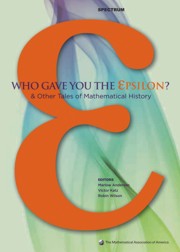Book contents
- Frontmatter
- Introduction
- Contents
- Analysis
- Foreword
- Who Gave You the Epsilon? Cauchy and the Origins of Rigorous Calculus
- Evolution of the Function Concept: A Brief Survey
- S. Kovalevsky: A Mathematical Lesson
- Highlights in the History of Spectral Theory
- Alan Turing and the Central Limit Theorem
- Why did George Green Write his Essay of 1828 on Electricity and Magnetism?
- Connectivity and Smoke-Rings: Green's Second Identity in its First Fifty Years
- The History of Stokes' Theorem
- The Mathematical Collaboration of M. L. Cartwright and J. E. Littlewood
- Dr. David Harold Blackwell, African American Pioneer
- Afterword
- Geometry, Topology and Foundations
- Algebra and Number Theory
- Surveys
- Index
- About the Editors
The History of Stokes' Theorem
from Analysis
- Frontmatter
- Introduction
- Contents
- Analysis
- Foreword
- Who Gave You the Epsilon? Cauchy and the Origins of Rigorous Calculus
- Evolution of the Function Concept: A Brief Survey
- S. Kovalevsky: A Mathematical Lesson
- Highlights in the History of Spectral Theory
- Alan Turing and the Central Limit Theorem
- Why did George Green Write his Essay of 1828 on Electricity and Magnetism?
- Connectivity and Smoke-Rings: Green's Second Identity in its First Fifty Years
- The History of Stokes' Theorem
- The Mathematical Collaboration of M. L. Cartwright and J. E. Littlewood
- Dr. David Harold Blackwell, African American Pioneer
- Afterword
- Geometry, Topology and Foundations
- Algebra and Number Theory
- Surveys
- Index
- About the Editors
Summary
Most current American textbooks in advanced calculus devote several sections to the theorems of Green, Gauss, and Stokes. Unfortunately, the theorems referred to were not original to these men. It is the purpose of this paper to present a detailed history of these results from their origins to their generalization and unification into what is today called the generalized Stokes' theorem.
Origins of the theorems
The three theorems in question each relate a k-dimensional integral to a (k – 1)-dimensional integral; since the proof of each depends on the fundamental theorem of calculus, it is clear that their origins can be traced back to the late seventeenth century. Toward the end of the eighteenth century, both Lagrange and Laplace actually used the fundamental theorem and iteration to reduce k-dimensional integrals to those of one dimension less. However, the theorems as we know them today did not appear explicitly until the nineteenth century.
The first of these theorems to be stated and proved in essentially its present form was the one known today as Gauss's theorem or the divergence theorem. In three special cases it occurs in an 1813 paper of Gauss [8]. Gauss considers a surface (superficies) in space bounding a solid body (corpus). He denotes by PQ the exterior normal vector to the surface at a point P in an infinitesimal element of surface ds and by QX, QY, QZ the angles this vector makes with the positive x-axis, y-axis, and z-axis, respectively.
- Type
- Chapter
- Information
- Who Gave You the Epsilon?And Other Tales of Mathematical History, pp. 78 - 87Publisher: Mathematical Association of AmericaPrint publication year: 2009

